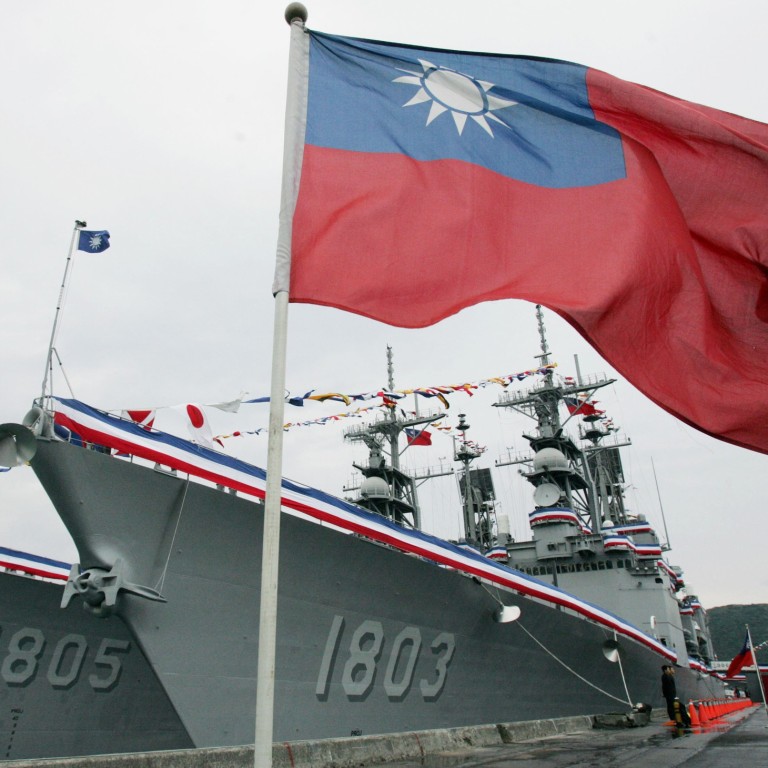
Exclusive | US warships made 92 trips through the Taiwan Strait since 2007
- Figures obtained by the South China Morning Post show the extent of operations carried out in the sensitive waterway between 2007 and April 2019
- Two US destroyers passed through the strait on Sunday and Monday, prompting Beijing to express ‘concern’ over the transits and describe the issue of Taiwan as ‘the most important sensitive issue in Sino-US relations’
The figures from the US Pacific Fleet show the extent of operations carried out in the waters between 2007 and April 2019.
The number of passages through the strait peaked at 12 in 2016, the same year Tsai took power in Taiwan, straining relations with Beijing.
The US did not announce the transits at the time, despite their increased frequency, and China does not appear to have reacted publicly.
The People’s Liberation Army did, however, make its objections known on two occasions in the past 20 years when US aircraft-carrier battle groups passed through the strait.
The first, in 1996, resulted in a missile confrontation known as the Taiwan Strait Crisis. The second, in 2007, prompted Beijing to reject all requests for American warships to make port calls in Hong Kong for almost a year.
Exclusive details and footage emerge of near collision between warships in South China Sea
The Post had sought figures from the past 10 years through a Freedom of Information Act request in November, but it was the US Pacific Fleet press office that provided the information this week.
James Kraska, a professor of international maritime law at the US Naval War College in Rhode Island, said Washington intentionally avoids announcing transits and overflights so as to make them appear unexceptional and routine.
“The idea is to ensure that these are considered normal operations and not antagonising,” he said.
The number of transits dropped to five in 2017, Trump’s first year in office, and three in 2018. There have been four transits so far this year.
Two destroyers, the USS Stethem and USS William P. Lawrence, were the most recent American vessels to pass through the strait on Sunday and Monday.
Beijing on Monday expressed “concern” over the transits, and described the issue of Taiwan as “the most important sensitive issue in Sino-US relations”. The remarks were considered a milder response than previous “stern protests”, which some analysts attributed to the decision of the crews to turn on their vessels’ automatic identification systems.
British universities wrestle with anxiety over links to Chinese tech giant Huawei: investigation
“My view is that usually if these transits took place and were taken as just a normal passage by any ship, without any formal announcement or reporting by the press, there would have been no reason for Beijing to raise its objection,” said Collin Koh, a research fellow at the Institute of Defence and Strategic Studies in Singapore.
“Of course, the context is often important. Especially during the current Tsai Ing-wen administration which is at loggerheads with the mainland authorities, when such passages are announced or reported widely in the press, Beijing must have felt the obligation to respond forcefully, if not in action, but at least in words.”
Nate Christensen, deputy spokesman for the US Pacific Fleet, said transits through the strait were part of the “US commitment to a free and open Indo-Pacific”.
“All of our operations are designed in accordance with international law and demonstrate that the US will fly, sail and operate wherever international law allows,” Christensen said.
The US Department of Defence does not routinely disclose its movements in the strait, only producing an annual report for Congress that lists the “excessive maritime claims” that were challenged by US vessels during the previous year. Periodic disclosures of transits by US vessels by Washington and Taipei on a case-by-case basis in recent years have prompted strident protests from Beijing, which claims the entire body of water lies within its jurisdiction.
Western governments have been made to fear China’s Huawei, but Ireland’s can’t afford to
Richard W. Hu, an expert in Sino-US relations at the University of Hong Kong, said Washington’s decision on whether to announce the transits was potentially more significant than their frequency.
“The transits occur for various reasons: some just for logistical reasons, and some for political reasons,” Hu said. “If we want to make sense of the frequency of transits, we could generalise that the frequency will increase whenever the tension across the Taiwan Strait rises.”
Bill Hayton, an associate fellow with the Asia-Pacific Programme at Chatham House, said protests by Beijing about the presence of international vessels in the strait would likely encourage Washington to carry out more such operations.
“Ironically, the more that [China] makes vague statements that suggest that it regards the strait as ‘internal waters’, the more likely they are going to provoke US transits through it,” Hayton said. “The point is that the US regards these transits as entirely normal and unremarkable activity. Therefore it won’t highlight them on principle. We usually only get to hear about them when someone else – usually [China] – makes a fuss.”
Cold calls: Australia’s after-hours veterans helpline has long wait times, low connection rates
However, Wu Xinbo, director of the Centre for American Studies at Fudan University in Shanghai, said Washington’s maritime operations were unlikely to influence Beijing’s stance on key issues such as Taiwan.
“Sometimes the transit is supposed to send a signal to China; especially when there is an obvious increase in the number of such transits, they are intended to exert pressure on China,” Wu said. “But I don’t think it works that way, i.e., the pressure doesn’t really alter Beijing’s behaviour either on the Taiwan issue or on other issues.”


